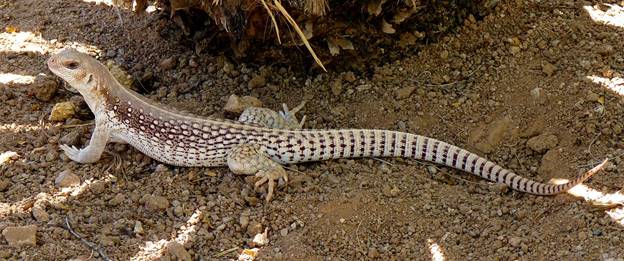What draws us into the desert is the search for something intimate and remote. -Ed Abbey.
This is a fairly large lizard – up to 24 inches long including its tail. It is a pale gray or whitish with a tan or brownish reticulated pattern on the back and sides. It has a row of slightly enlarged keeled scales on the back with rows of brown spots on the tail, which is as long as the body. During the breeding season the sides of the body become pinkish in both sexes. All in all, this is a rather handsome lizard.
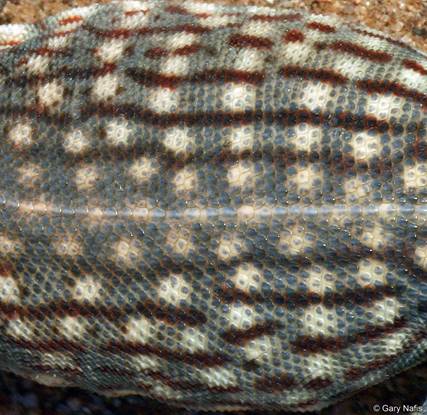
It is found in southeastern California, southern Nevada, southwestern Utah and south-central Arizona in the U.S. Its range extends into Mexico including eastern and southern Baja California, northwestern Mexico, and some of the Gulf of California islands. The range of the desert iguana largely corresponds with that of the creosote bush, areas dominated by dry, sandy deserts. In the southern portion of its range it can be found in subtropical scrub and tropical forest associations. It was first described in 1859 by Spencer Fullerton Baird, who became the first curator of the Smithsonian Institution.
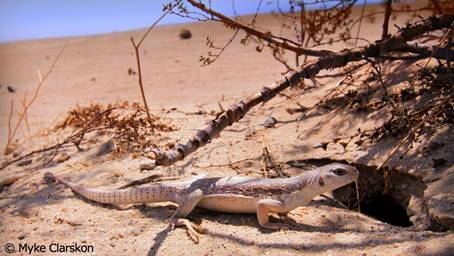
The genus name comes from a combination of the Greek words Dipsa for thirsty, and sauros for lizard – thirsty or hungry lizard. The specific name, dorsalis, comes from the Latin word dorsumfor spike, in reference to the row of enlarged keeled scales on the back that form a crest that extends almost to the tip of its vent.
Not only are they found in the low desert, but they just love, love the heat. When other lizards have retreated to their burrows to avoid the mid-day scorching sun, you can find the desert iguana wandering around or just basking. Their body temperature can rise to 116° F – the highest recorded for any reptile. Desert iguana burrows are typically found beneath a creosote bush and they will quickly scamper into it if disturbed. They will either dig their own burrow or use one developed by kit foxes or desert tortoises. Its long tail helps in climbing through creosote branches in search for flowers and to escape the hot sand for a bit.
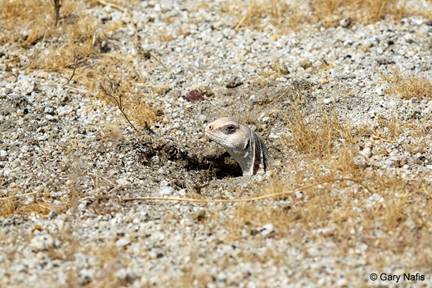
hese lizards are herbivorous, foraging on buds, fruits, and leaves of many annual and perennial plants. They are especially fond of the yellow flowers of the creosote bush. Desert iguanas are preyed upon by foxes, rats, long-tailed weasels, and some snakes. Long-nosed leopard lizards are known to prey on desert iguanas. Humans will take them for pets. But for a mere $49.99 you can order a captive-bred one for next day delivery Order an Iguana
Unlike most reptiles, the home range of females (0.38 acres) is nearly identical in area to that of the males (0.36 acres), and may reflect the near lack of size sexual dimorphism (size difference) in the species. Male home ranges overlap considerably while females do not. One researcher determined that males who establish territories around large shade plants have access to a greater number of females. Overall density of these lizards varies. In the Coachella Valley in CA densities were 300-700 per hectare whereas 90 miles to the east in the more arid Chuckwalla Valley densities were only 60 lizards per hectare, presumably due to more limited food resources.
Desert iguana activity in the Sonoran Desert extends from March to September, but juveniles may become active as early as February and extend into October. Females have been noted to stop their activity following egg-laying indicating they may be brood eggs at this time. Following mating, a clutch of 2-8 eggs are laid in late May or early June. Hatchlings emerge during a four-week period centered in August.
In general, with some exceptions, larger lizards (greater than 3.5 oz.) are herbivorous and smaller ones eat a mix of plants and animals. Physiologically, it is harder to make a living eating plants because you need to eat so much more because of the challenge of digesting cellulose. In examining the gut structure of iguanines a researcher determined that desert iguanas are the least specialized for digestion of plant material. It is thought that the preferred high body temperature of this species may facilitate digestion of plant material by this relatively small iguanine herbivore. It also has been suggested that the consumption of mammal feces may help supply the micro-organisms to the digestive track needed for processing plant material.
I once attended a wedding of a member of the Velvet Underground in the Saline Valley of CA (long story). This is one valley over from Death Valley and is low desert, full of creosote bushes. We camped for the week at end of the 4×4 road at the nicely rock-lined hot springs, supposedly developed by some seasonal BLM staff who had a lot of creativity, too much time, and access to dynamite. It’s 35 miles from the nearest paved road.
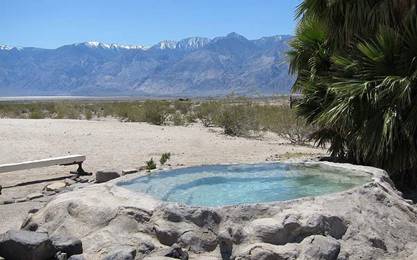
The routine went something like this – a late afternoon soak in the hot pools, then as the sun angle decreased the instruments came out and dinner began, followed by storytelling and star-gazing. Up early for lizard and snake hunting, breakfast, a soak in the hot pool, and then maybe a canyon hike before it got too hot.
In the middle of the day while most folks were following the shade around the creosote bushes, I’d go for a lizard walk. I came across a pair of desert iguanas just lying around in the 95° heat. They were warmed up and there was no way you could get closer than a few feet from them. Desert Iguana Feeding
But I did have my lizard noose with me. Curiously, if you take a thin gauge of wire and extend it on a stick and make a slip noose on the end, lizards don’t get alarmed at this approaching them as they would your hand. You slowly move the noose towards them and place the open noose over their head. With a gentle tug upwards you lift their front feet off the ground and snatch them up.
So I caught the male and what a beauty he was. I trotted back to camp to show him around and then placed him back where I found him. His mate was waiting for him and when I released him they kinda bumped noses and then went back to their middle-of-the-day routine and just hung out. I went back to camp to look for some water and some shade.
